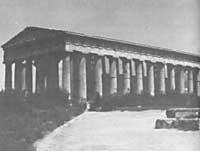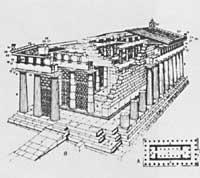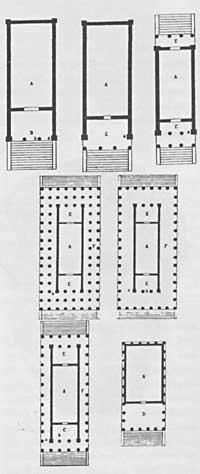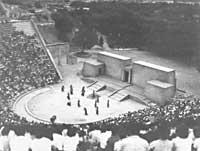The origin of science in Greece: science in C. A. C. In the 5th century

In the fifth century, however, we can affirm that the distinction between philosophy and science has taken a step further. Philosophers, on the other hand, had to further define and deepen the thematic areas of their thinking. Science would focus more on its special world.
Unfortunately the text of this century hardly exists. However, with the existing we can divide the century into three major terms: The eleatarra school, that of the atom and the terms of the sophists. But before working with them, we will have to study the results of Heraclitus and Anaxagora:
Heraclitus of Ephesus a. C. He wrote about the year 484. More than a man of science he was a philosopher and a poet. He rejected the materialistic tendencies of Anaximandro and Anaximen. In his opinion, the basic element was something like eternal fire, a kind of mind matter. All things were made through this element and returned to it. The decline of adverse phenomena observed in the world (cold/heat, life/death, etc.) is the appearance of the fire that is always alive, said. All things move orderly and go non-stop: "panta rei".
Heraclitus, by himself, did not bring too many new things and, despite seeing the diversity and relativity of things, his job is to flee the rational expression of things.
Al Anaxago de Klazomas: Apparently, a. C. He lived between 499 and 428. Although he was Ionian, he moved to Athens, where he obtained the help of the city's most famous man, Pericle. There he was professor of Euklider.

Anaxagora wrote a work on Nature. Currently there are only three pages. In his opinion, nothing is born or dies. There is only mixture and decomposition. The universe at first was a set of disproportionate seeds, configured and ordered by the mind through the rotation movement. Anaxagora's thought has hardly any scientific basis. However, he spoke about astronomy, biology, anatomy and medicine.
The Eleatarra school: The philosophers of the Church of Southern Italy also developed a type of a priori critical philosophy. Its founder was Parmenide. This, a. C. He lived around 480.
This philosopher fascinated by enthusiasm, although the senses say otherwise, brought the axiom that says "the unthinkable is not possible" to the final limit. Reason like this: creation is impossible; it is impossible to think that something comes out of nothing or that it is not being, so it is not possible. On the contrary, crushing is impossible, because a thing of nature cannot become anything. Change is also impossible, because one thing cannot be born of another which is different in itself.
Therefore, the appearances of changes in time and space we hear, differences and multiple are only fictitious images that give us the senses and deny us the mind. The senses do not lead us to the truth, that can only be done by imagination.
As for the History of Science, ideas about its astronomy are more important. According to him, the Earth was a sphere divided into five parts. It is difficult to know where the idea of esfericity came from. However, even some Pythagoreans previously accepted the same. But, based on this idea, the Universe came to think of Earth as a set of concentric spheres. The Earth would be still in the center of this whole. Among these spheres we would be leading hydigies to God. As we see, the purely metaphysical approach led to certain consequences that are true.

Zenon de Elea: He developed some ideas from Parmenide and demonstrated, among other things, the absurdity of considering change and diversity real. Aristotle perhaps appointed him inventor of dialectics because he made a systematic use of the law called "reductio ad absurdum". He rejected the Pythagorean doctrine that all things were made with elementary numbers and thought that with his paradoxes he had crushed the concept of diversity:
Diversity must be infinitely fractional and therefore infinite. But it is not possible to follow the opposite path: that is, it is impossible to complete a complete finite with small infinite parts. Or, when the Akile corridor goes after a turtle, arriving at the point where the turtle was at the other point, and when Akile returns to this second point, and..., so Akil will not catch the turtle to the top. Or "still" in the air, or...
Actually, Zeno did not bring anything new to the area of Mathematics, but based on the ideas he established, the infinitesimal calculus has been built.

Pedokle de Agrigento: Within this diocesan school, the Sicilian Empedokle (a. C.) Lived around 450). He did his work on philosophy, poetry, astronomy, physics, biology and medicine. He postulated the existence of four elements (earth, water, air and fire) and two forces, the centripetal (love) one centrifugal (hatred). All there is consists of these eternal and permanent elements. These can be joined by love or hatred of the hip.
The ideas about astronomy of the pedokls are very detailed and is to go back to the previous ones. The kneading was a glazed, egg-shaped surface, where the stars were glued and the planets free. In the garden, on the other hand, there would be two plots.
In the field of physics, however, its outcome was more fruitful. To do this, he prepared in the lower base many small holes and in the upper one a closed container with a single normal hole. If the container is immersed in the water with the hole above closed with your fingers, it is not filled with water. On the contrary, when removing the finger enters the water. From this experiment he drew two conclusions: one, that vacuum and air were different, and another that steam and air were two things.
He also took care of the area of light. According to Pitagora and his followers, the basis of vision was particles emitted by bodies or sensitive rays coming out of the eye. For him, the rays emitting light bodies collide with those coming out of the eyes. Your idea of light speed may be more important than: For Enpedokle the speed of light had to be finite (V. Aristotele "De sensu").


In the field of biology, according to Aezio, the results of Enpedokle must be taken into account. In the words of Pedokle, plants were born before animals and their difference lies in the qualities and forms of the mixture of elements: mixing the four elements with the same dimensions produces meat; if the proportion of fire and water is twice that of others, nerves are formed, etc.
As for embryology, says Aristotle that Enpedokle has a breathless life, that after having sexual coverage, within twenty-six days occurs in the uterus and that the members are formed on the day of the larogeitamaikos. Galen, for his part, accuses him of several results in this field: twins, for example, for the sobriety of the erneracea liquid. But in the field of medicine, without lips, the greatest result of Empedokle is the implantation of a new scientific environment in which the disease is found in the structure of the living being, and even in the structure of matter.
Atomists: If Empedokle thought that all bodies could be expressed through their four elements, the atosmixtes took this theory further to construct the theory of atoms based on the theory of the unique ancient elements.
Ancient references include the names of Leuzpius and Democritus as founders of the theory of atoms. But Democritus' fame and works have almost completely marginalized Leuzipo. On the other hand, we know little about Leuzpio. All his writings, except the next sentence, are lost. The phrase is: "Without reason nothing happens, everything has its cause and is a consequence of necessity."
The foundations of Greek atomic theories are very different from those that have given rise to current atomic theory. Researchers from the Dalton era, who had many measurements, were able to verify that the theory being built was mostly in accordance with these measurements. However, the Greeks had no concrete data. His theory was based on a philosophical scheme with the unverified cosmos.
These philosophers, based on the general knowledge of their time, reasoned the idea through metaphysics: What happens by successively dividing matter? Do their characteristics last? Will land and water continue in this process? Or in other words, the characteristics we see in bodies are a last spontaneous and inexpressible thing or, on the contrary, they can be expressed with something simpler and, therefore, could we go any further on the path of knowledge?
The search for a simplified expression has had a great importance in the history of scientific thought. According to the preconceived ideas of these philosophers and the fall of atomic philosophy, it was thought that the characteristics of things corresponded to their essences, that is, they recognized that the acidity of salt or the greenness of the leaves were as real as salt or leaves, and they did not think that they could be expressed through other human functions or sensations.

It is good to see the origin of Greek atomic theory. As a basic element Tales takes water, Anaximenes air and Heraclitus fire. On the other hand, the ancient Pythagorean theory was there. According to this, they were the last numbers of reality. By the way, they accepted the ideas of empty spaces, that is, without matter, although the latter thought that air was the same. Parmenid fought against this theory, but the atomists were resurrected by the difficulty in a compact interval to express particle movements. But at this time, since it was known that air was a real body, the empty space of the atomists was a real and authentic void.
The theory of simple particles, dispersed in pure matter, arises in this medium. This theory allowed us to express the most important actions of the time: evaporation, movement, condensation, etc. However, the truth is that the real problem persisted, was the atoms themselves fractional? The atomists said they were physically indivisible, because inside it was not empty.
As we have said before, the first atomists are Leuzipo and Democritus. First the school of Abdena. It was built in the 5th century and the second in Abdená. He was born in 460. The ideas of the latter are known by some references of Aristotle and by the work of Epicurus (341-270). In a general course of philosophy taught by Epicurus in Athens (ethics, psychology and ethics) he expressed atomic theory. Two centuries later, this theory was redeveloped by miller Lukrezio.

Democritus taught: "It is often believed that sweetness and bitterness, heat and cold, or colors, are expressed spontaneously. In reality there are only atoms and emptiness." He rejected the relativistic ideas of Protagoras. According to them, "the size of all things is man." Therefore, while the sugar is sweet in my opinion, it can be bitter for another. In addition to the theory of atoms, Democritus saw that the only way to detect reality is the way of meaning.
Democritus' atoms were always expressed, that is, they were unfounded and never annulled: "They were strong in their compact unit." They were unique substances but very different in shape and volume. Therefore, qualitative differences are based on the different volume, shape, position or movement of the particles, since they are all equal in terms of the nature of the substance. Thus, while the movement of atoms in iron or stone is a vibration, they can leap far into fire or air.
Moving in all directions of unlimited space, atoms meet together, creating the movements of the sides and ramps. Thus appear different elements and countless worlds. They grow, decrease and decompose, and only those that are adapted to the environment remain. Here one can see in some way the first traces of the hypothesis of the original nebula and Darwin's theory of natural selection.
This theory, in its original form, recognizes neither the weight nor the weight nor the upper and lower absolute weights. On the other hand, as long as there are no obstacles, the movement will continue. For Aristotle these very appropriate ideas were incredible. Democritus' doctrine facilitated the vision of Nature. It is necessary that this approach be too simple, since atomists jumped above some difficulties that still persist today, because in some problems of life and consciousness that do not accept mechanistic expression they wanted to use their theory.

Leaving aside the influence that Democritus' atomic theory can have in the field of philosophy, it must be said that it is much closer to science than any other system prior to or after current ideas. And from this perspective, burial under the criticism of Plato and Aristotle should be considered a very important loss. Plato's ideas for generations to come, in their different forms, housed a true Greek reflection. Hence, among other things, the scientific spirit disappeared for a thousand years. Although Plato must be considered a true philosophical barrier, it must be recognized that it was a real obstacle to the development of Science.
Hypocratic medicine
The medicine of the Greek world can be considered as science. Hippocrates (BC) In 420 years he is his most famous man but not the only one. Under the name of hypocratic medicine is covered the scientific movement on healing that overcomes the empirical and magical situation. Before Hippocrates the healing was in the hands of Eskulapio (god of healing), the priests of the church and the sorcerers.
However, a. C. Around 500 Krotona's Alkmeon used dissection, discovered the optic nerve and found that the brain was the main organ of sensation and reflective activity. Anaxamines experimented with animals and investigated their anatomy by dissection. Enpedokles indicated that blood circulates through the heart.

This school took theories and paths similar to the current ones of medicine and, of course, much more advanced than those of any intermediate epoch. His physiology did not deal with the last cause, as did Aristotle and Galen. On the contrary, he studied the cause and nature to find the remedy. Illness was considered to be something that was within the legislation of Nature. Therefore, the precise observations and meanings of the symptoms were of great importance. Therefore, many of the diseases they suffered were declared with the corresponding cure. They used experimental means and knew anatomy, at least to some degree.
An unforgettable part of this school is its deontological side. This materialized through his "Cinema". For this reason, before being admitted to the medical table, they committed to meet a number of requirements. However, Zina, more than the ethical code, is a type of contract that allowed to build medicine on a guild basis.
This school adapted reasoning to a technique. He laid physiology as the fundamental basis of medicine and endowed medicine with its own personality.





